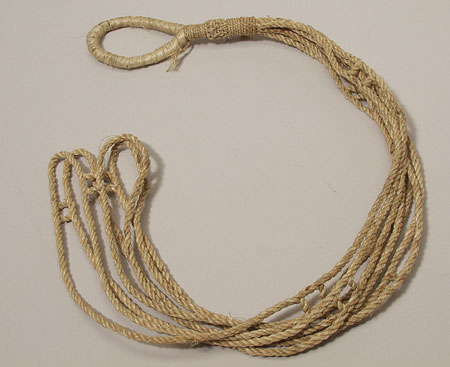Accession Number:
1979.20.32
Country:
Sudan
Region:
[Southern Sudan] Western Equatoria ?Lui ?Lanyi
Cultural Group:
Moru Misa
Date Made:
By 1979
Materials:
Grass Fibre Plant
Process:
Twisted , Tied , Bound
Dimensions:
L = 775 mm, diam cord = 5 mm, L loop = 90 mm [RTS 23/8/2004].
Weight:
77.3 g
Other Owners:
Collected by Patti Langton between 27th January and 5th February 1979 as part of the British Institute in Eastern Africa's Expedition to the Southern Sudan [RTS 15/6/2004].
Field Collector:
Patti Langton
PRM Source:
Patti Langton
Acquired:
Purchased 1979
Collected Date:
Between 27 January and 5 February 1979
Description:
Sling made from strands of yellow grass (Pantone 7508C), twisted and woven together at intervals to form a net bag which can be used to hang or possibly carry vessels.
This consists of a bundle of grass, bent into a large open loop at one end and bound around with grass strips to maintain the shape.
This loop is 90 mm long.
The ends of this join together to form a solid cylindrical body with the grass bundle probably twisted to form a series of cords from this point onwards.
The top and bottom part of this cylindrical 'handle' have been wound around with thin cords of 2 ply twisted grass fibre, knotted together at the ends and with these ends tucked under the binding to secure them.
The central part between these is made from a slightly thicker cord woven into a solid body with oblique and horizontal elements.
This handle has a total length of 60 mm below the loop, and is 17.4 mm wide and 17.2 mm thick.
Below it, the the body divides into 8 cords, each of which is made up from triple twisted fibre strands that continue from the core of the handle.
These are grouped in 4 pairs, and after a stretch of 110 mm, each pair is joined by passing a single strand from each cord horizontally across to link it to the adjacent cord, with the two strands meeting and being twisted together as they pass one another.
This is repeated 2 cm further down - creating two short horizontal bars that run between the vertical cords.
After another 210 mm, each cord is joined using a similar technique to its neighbours on left and right respectively, and this is repeated a third time just above the base of the sling, creating an open network body with large lozenge-shaped gaps in the sides and at the centre of the base.
It is complete, with a total length of 775 mm; each of the vertical cords has a diameter of 5 mm, while the total weight is 77.3 grams.
While similar slings are sometimes used to carry vessels, unlike those this example has a very short neck above the network body, suggesting that it may have been designed for simply hanging, rather than transporting pots.
Purchased by Patti Langton between 27th January and 5th February 1979 as part of the British Institute in Eastern Africa's Expedition to the Southern Sudan. No purchase price or provenance was recorded; the expedition was collecting Moru material during this period from the settlements of Lui and Lanyi, in Western Equatoria. The Moru name for this type of object was not recorded.
Rachael Sparks 6/9/2005.
Purchased by Patti Langton between 27th January and 5th February 1979 as part of the British Institute in Eastern Africa's Expedition to the Southern Sudan. No purchase price or provenance was recorded; the expedition was collecting Moru material during this period from the settlements of Lui and Lanyi, in Western Equatoria. The Moru name for this type of object was not recorded.
Rachael Sparks 6/9/2005.
Primary Documentation:
Accession Book Entry
[p.
185] - 1979.20 (.1 - 206) P[urchase] MISS PATTI LANGTON, DEPT.
of ETHNOLOGY & PREHISTORY, OXFORD.
Collection made by Patti Langton during the British Institute in East Africa's expedition to the Southern Sudan; Jan.
- April 1979.
The collection was made in three culture areas during the dry season.
The amount paid for each object is listed if the information is known.
In Jan.
1979 £1 is equivalent to 95 piastres (pt.) Sudanese.
This documentation is based largely upon Patti's own list of objects and her notes on these.
Sometimes objects included in the Pitt Rivers alottment of the collection do not appear on her list and have been added here.
See Related Documents file as well.
[pp 185 - 186] 1979.20.1 - 42 SOUTHERN SUDAN the MORU MISA The Moru Misa live about 100 miles west of Juba, the capital of the Southern Sudan.
Part of the collection was made in Lui, a small town which has had extensive church and missionary activity over the past 50 years (excluding the period of civil war) and which now boasts a church, a hospital and a number of schools.
The rest of the Moru Misa collection was made at Lanyi, 15 miles away, where the paramount chief of the area, Chief Elinama, arranged for people to bring artifacts for us to buy.
Although money is known to the Moru, its use is limited and the concept of selling belongings is foreign to them.
Hence the low prices and the relatively small number of artefacts.
The Moru Misa are a geographical section of the Moru people.
The Moru practice agriculture for subsistence; they do not keep cattle any longer.
[p.
189] 1979.20.32 - Grass pot holder made of twisted grass strings tied together with a loop at one end.
L = ca.
78 cm.
Unnumbered.
Additional Accession Book Entry [in red biro under accession number] - A5-F32-20.
Card Catalogue Entry - There is no further information on the tribes catalogue card [RTS 2/6/2004].
Additional Accession Book Entry [in red biro under accession number] - A5-F32-20.
Card Catalogue Entry - There is no further information on the tribes catalogue card [RTS 2/6/2004].



